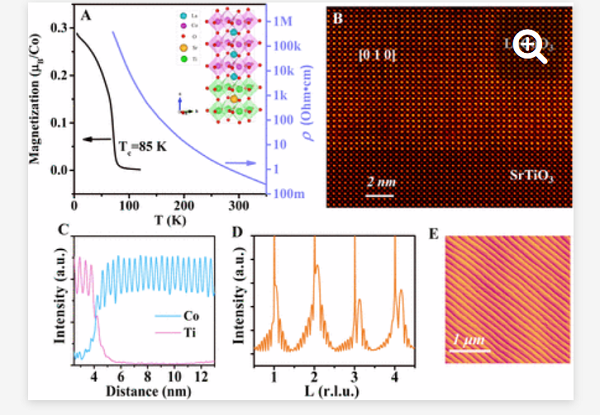The research team of the quantum functional materials and advanced photon technology in USTC led by professor LU Yalin has made important progress in quantum functional materials. They combined high quality oxide film preparation, synchrotron radiation advanced photoelectric detection and first principle method in the study of new high temperature and high symmetrical ferromagnetic insulator. A new type of ferromagnetic insulators above the liquid nitrogen temperature (77 k) with high symmetry was found and a new mechanism of high temperature ferromagnetic shift was explained. The results were published in Proceedings of the National Academy of Sciences (PNAS), on March 5th, 2018.

Generally, magnetic materials can be divided into conductive ferromagnetic materials and insulated antiferromagnetic materials. With the boost of quantum science and technology, increasing demand is raised concerning the material performance of quantum function. For example, in quantum topology of ferromagnetic, to produce promising quantum devices, materials need to be insulating and high lattice symmetric.
Ferromagnetic insulators are mostly made up of two magnetic atoms occupying different positions to make their orbits different, e.g. famous Y3Fe5O12 (YIG). But they are complex, low symmetry of the lattice structure. The same kind of atom can easily occupy different lattice grid points, so the preparation of high quality ferromagnetic insulator is very difficult.What’s worse, applied to magnetic quantum devices or tunneling devices, these ferromagnetic insulators is hard to gain epitaxial growth with other materials of high symmetry, resulting in the difficulty of device preparation and integration in the future.
On the other hand, known, all high symmetric non-doped ferromagnetic insulator has low ferromagnetic transition temperature (mostly below16K), which is highly below the liquid nitrogen temperature. Due to the weak supercharge interaction between oxygen, these materials have narrow 4f track resulting in the low temperature ferromagnetic insulation. To develop new quantum materials, we must work on the inner physical mechanism. This is a hard task both in physical study and material preparation ways.
In order to obtain the material satisfying the qualities above, the team selected LaCoO3 film from various materials as the one most potential. But at first the appliance of LaCoO3 aroused debates, as it is demanding for equipment and easily appear defects which, some believed, leading to unstable and uncontrolled material performance. Luckily, the team members toke advantages of a high quality single crystal thin film preparation and developed a high quality, approximate zero defect LaCoO3 film.
Further research shows that LaCoO3 film is a rare high temperature ferromagnetic insulator, with ferromagnetic transition temperature above liquid nitrogen temperature as 85 K (5 times of previous materials).
Exposed to different oxygen content and stress with different thickness, LaCoO3‘s ferromagnetism decreased with increasing oxygen defect concentration. When Co2+ concentrate reaches 10% due to the oxygen defect, ferromagnetic disappears completely. First principles calculation proves the experimental results. When oxygen defects are introduced into the LaCoO3 film under tensile stress, high spin state of Co2 + (t2g3eg2) appears and interacts with high spin state neighboring Co3 + and high spin state Co2 + ,forming local antiferromagnetic interaction, as a result, weaken the ferromagnetic. Moreover, when the concentration of Co2+ reaches 12.5%, the anti-ferromagnetic interaction replaces the ferromagnetic interaction becoming the new long process, thus the ferromagnetism disappears completely.
These experiments and theoretical work fully demonstrate the LaCoO3 thin film ferromagnetic insulation mechanism and provides a new material for the future development of high quality magnetic quantum devices and other applications.
The team member including associate Professor ZHAI Xiaofang, Professor FU Zhengping, etc. cooperated with Doctor GUO Jinghua from the Lorentz Berkeley national laboratory, Professor ZHAO Jin from USTC and professor MA Chao from Hunan University. The co-first authors are Doctor MENG Dechao and GUO Hongli from Hefei national laboratory for physical sciences at the microscale and the corresponding author are associate researcher ZHAI Xiaofang and professor LU Yalin. This work was funded by key projects of the ministry of science and technology, the national natural science foundation of China, the Chinese academy of sciences and the ministry of education.
Links: http://www.pnas.org/content/early/2018/02/28/1707817115
(Written by LIN Yujie, edit by YANG Xinqi, Hefei national laboratory for physical sciences at the microscale, national synchronous radiation laboratory, and scientific research department.)